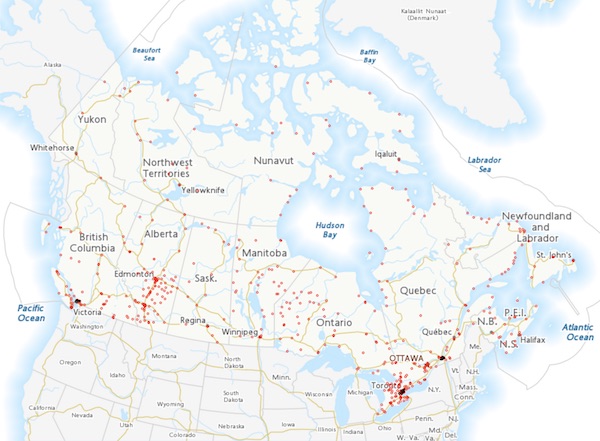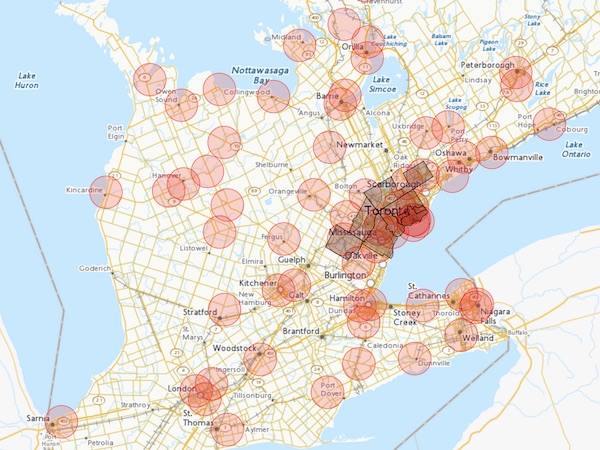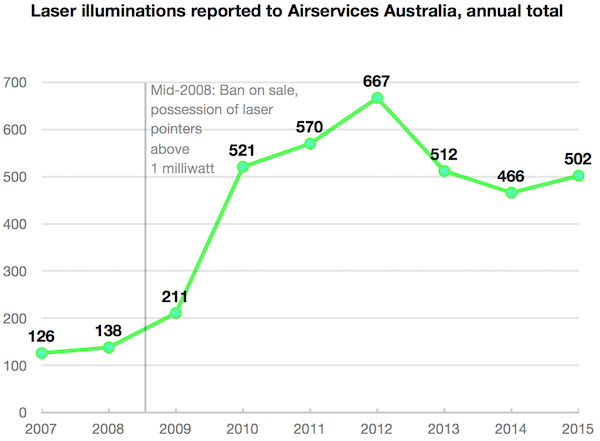Home
A comprehensive resource for safe and responsible laser use
Canada: Restrictions on high-powered handheld lasers in three cities
Persons are banned from possessing such lasers outside of their home, without a legitimate purpose such as work, school, education or astronomy.
Police can question anyone with a laser in one of the prohibited zones if they had a reasonable reason to search them. Examples given included if a member of the public contacted police with a specific description of a person they saw holding a laser, or if police themselves saw the person holding a laser.
Any person with a battery-operated, handheld laser in a prohibited zone 1) outside of a private dwelling and 2) without a legitimate purpose could be fined immediately and “on the spot” up to CDN $5,000. A corporation violating the law would be fined up to CDN $25,000. The fines are in addition to any criminal prosecution; intentionally aiming a laser at an aircraft could result in five years in prison and/or up to CDN $100,000 in fines.
According to Transport Canada, “You don’t need to carry any documentation, but you should be prepared to demonstrate to the officer why you’re in possession of a hand-held laser. Law enforcement will be trained to know when and where people may possess a laser. They will exercise their discretion and judgement when determining whether or not to issue a fine.”
Transport Canada has a webpage with details of the laser prohibitions, a question-and-answer page about the new laser safety measure, and an online forum “Let’s Talk - Lasers” seeking feedback on laser safety issues. The “Let’s Talk - Lasers” consultation closes for comments on August 27 2018.
They also have an online interactive map detailing the prohibited zones. Here are two examples of map output:

Laser-prohibited zones in the entire country
Closeup of laser-prohibited zones in the Toronto area
The three metro areas of Montréal, Toronto and Vancouver were included since, according to Transport Canada, “The majority of reported laser attacks have occurred in these regions. Transport Canada will continue to monitor the number and location of reported incidents and may adjust the included municipalities as warranted.”
The agency discussed how the fines were determined, and how law enforcement will decide on the exact fine amount: “These fines, called administrative monetary penalties, come from the Aeronautics Act and the Canadian Aviation Regulations. Law enforcement uses discretion on how much to fine an individual. The amount may depend on previous infractions and circumstances surrounding this infraction.”
When concluding his announcement, Garneau stated “we have the tools that law enforcement agencies need, including Transport Canada inspectors and police forces, in order to put an end to these careless and reckless actions — actions that could have tragic results.”
From the Canadian Press, the CBC, iPolitics, a video of Marc Garneau’s announcement on GlobalNews.ca, and the Transport Canada informational webpage and Q&A webpage.
For much more information and commentary from LaserPointerSafety.com:
Additional information
LaserPointerSafety.com has additional information on the number of laser/aircraft incidents in Canada on (scroll down on this page), and a comparison with U.S. incident rates. We also have news stories about laser illuminations of aircraft in Canada, about non-aviation laser misuse in Canada, and about Canadian statistics and laws and other laser news. Those interested in existing Canadian laws about laser misuse can find them here.
Commentary from LaserPointerSafety.com on past education efforts not working
The June 28 2018 restriction comes after disappointing results of efforts to educate Canadians about the hazards and illegality of aiming lasers at aircraft.
On June 24 2015, the government announced an infographic, digital advertising, awareness videos, a direct mail campaign and a website — all around the idea that pointing lasers at aircraft is “Not a bright idea.” The campaign was especially focused around Canada’s three largest airports. At the time, there had been around 475-500 pilot reports of seeing or being illuminated by lasers in 2014. (Various Canadian sources give different numbers for the yearly incident total; the reason for the discrepancy is not known.)
The number of incidents rose to around 590-660 in 2015, despite the education campaign. On May 24 2016, Marc Garneau announced the awareness campaign would extend to social media as well. This may have helped the reduction in 2016 (527 incidents) and 2017 (379 incidents).
On the other hand, laser incident rates also dropped by about the same percentage in the U.S. and the U.K. in 2016 and 2017 — countries without special awareness campaigns. (See the per capita chart comparing the U.S., U.K. and Canada on this page.)
The education efforts were not deemed sufficient by Garneau, who on February 15 2018 announced that Transport Canada would explore “all possible options” to reduce the number of laser/aircraft incidents.
In his June 28 2018 announcement of the restrictions, Garneau noted that laser incidents had dropped 25 percent in the past two years, but said “It's still too many. We want it to be zero. The education is working, but it's not working fast enough."
Commentary from LaserPointerSafety.com about whether arrests and prosecutions are a deterrent
A commenter on a CBC News page wrote “Based on news reports over the years it appears most of the people who point the handheld laser pointers into the cockpit of aircraft are caught.”
But this is incorrect. In the vast majority of laser/aircraft incidents, perpetrators are never found, arrested, prosecuted or convicted.
One reason may be the low rate of arrests and convictions. A 2014 study by Cyrus Farivar, summarized here, found that in the United States, less than 1% of reported laser/aircraft incidents led to an arrest, and less than 0.5% of incidents led to convictions.
LaserPointerSafety.com is unaware that this situation has improved since 2014, either in the U.S. or in Canada.
According to iPolitics, at the June 28 2018 press conference, “Garneau acknowledged that very few people are prosecuted due to the difficulty of catching them in the act.”
Commentary from LaserPointerSafety,com as to whether the restrictions could work
Australia’s experience with a 2008 ban on laser pointers over 1 milliwatt indicates that a ban will not be effective, at least not for many years. The chart below shows how laser illuminations of aircraft rose significantly the four years after the ban, and settled down to a rate that seven years later is still 350% higher than the pre-2008 incident rate.
In addition, because of the restrictions, many lasers imported into Australia have labels falsely stating they are below 1 milliwatt while tests show they are significantly higher. An Australian safety expert wrote "...the prohibition laws may have detrimentally affected laser pointer safety within Australia without overtly impacting availability....the one thing more hazardous than a correctly labelled high power laser pointer is a high power laser pointer labelled as safe."
While bans and restrictions may help somewhat over many years — perhaps a decade or more — no one should think that pilots will be safer and can relax once a ban is in place. Here are three reasons why: 1) Even 1 milliwatt lasers can be a vision-blocking hazard at close (hovering helicopter) range, 2) higher powered lasers will remain readily available to persons who want them (pre-ban lasers, purchases on the Internet or when visiting other countries, making their own, using external power sources with non-battery lasers), and 3) this will not dissuade any “bad guys” who might deliberately want to aim laser light at aircraft for crime distraction or to cause direct harm.
LaserPointerSafety.com believes that while bans could help, the single best counter-measure is mandatory pilot education and training.
The “last line of defense” is the pilot. Fortunately, a laser threat is only light — not a bullet or missile. Pilots who know not to panic, and how to respond, can safely control their aircraft even after a bright, flashblinding exposure. SAE ARP6378, published June 2 2018, details the procedures and education that pilots should have. It also discusses when and what type of laser glare protection should be used.
For more details, see the Perspectives & Opinions page “What should be done about laser pointers?”
